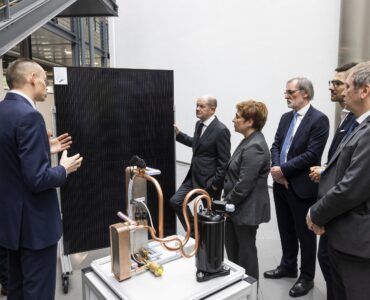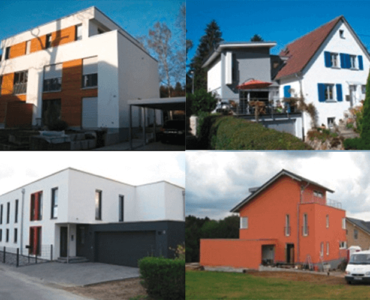Final episode of a series on heat pumps in existing buildings: We should have courage to bet on the right technology
“The signs are unmistakable. […] the cost of inaction is — keeps mounting. […] We have to move quickly to meet these challenges.” said U.S. President Joe Biden at the start of his online climate summit in spring 2021. He phrased this in a broader context, but it is also applicable to the heating transition in the building sector. We must deploy all suitable and available technological solutions now in order to achieve the climate goals and the targeted climate neutrality. Heat pumps are a key technology in this respect.
75% of residential buildings in Germany are older than 40 years. In many European countries the situation is alike. The figure illustrates how important it is to pursue the right energy strategy for existing buildings. Wherever possible, heating energy requirements should be reduced first. In the long term, this is will be essential anyway. However, the replacement of the heating device cannot always wait until after the energetical refurbishment of the building. This fact is often used as an argument against heat pumps. In our blog series “Heat Pumps in Existing Buildings”, we provided evidence proving that this assumption is wrong. It is possible (and necessary) to successfully use heat pumps in existing buildings from an ecological and economical point of view.
The main findings for heat pumps in existing buildings
First, the most important finding from the end-user’s point of view: heat pumps can provide the required amount of heat even on very cold days (episode 2). At the same time, our analyses have shown that it is not the maximal, but the average heating circuit temperatures that are decisive for overall efficiency. This means that heat pumps can provide the required heat with satisfactory efficiency even in existing buildings. Efficiency can also be further improved with the help of relatively inexpensive measures that can be implemented in the short term. These include replacing single radiators, for example. Modern radiators can transfer the same amount of heat to the room at a significantly lower flow temperature. Such simple renovation measures can be the first step in a medium-term refurbishment roadmap to achieve further efficiency improvements.
The results (episodes 3 and 4) from our field investigations of heat pump systems (Fraunhofer ISE has measured about 300 heat pump systems over 20 years) refute the widely held view that heat pumps can only be used with underfloor or wall heating. This is not only physically wrong, but is also disproved by thousands of heat pump systems implemented with radiators. Radiators do not necessarily require “very high” supply temperatures. In our field study, only a handful of the air-to-water heat pump systems that used radiators exclusively had average heating circuit temperatures above 45°C.
Another common prejudice against heat pumps is that the direct electric heating device must be used frequently, causing heating costs to “skyrocket.” Field studies clearly refute this assumption (episode 5). Both, theory and practice, show that the share of direct electric heating in the operation of correctly planned and designed heat pump systems does not exceed 3%, and in the vast majority of cases is even less than 1%. A larger share usually indicates a need for optimization of the entire heat pump system. It is thus clear that the use of the direct electric heating device neither has a relevant influence on the efficiency of the heat pump nor causes significant operating costs.
The ecological assessment (episode 7) showed that the use of heat pumps leads to a significant reduction in CO2 emissions compared to fossil-fueled heating systems, such as gas boilers. With increasing shares of renewable electricity generation, these savings will increase. The efficiency results from the field studies show that significant greenhouse gas reductions are readily achievable in both new and existing buildings.
Regardless of how ecologically sound a technology is, it will only catch on if it also has economic benefits for its users (episode 8). A heat pump with the currently typical efficiency of 3.5 is already economically advantageous over a gas heating system at today’s price structure in Germany. However, it is clear that the reduction of electricity prices in Germany is a key strategy for increasing the attractiveness of heat pumps compared to fossil heating systems. By systematically reducing the tax and duty burden on electricity, heat pumps will become the economically and ecologically preferable technology in almost all cases.
Our market review of the technological development status of heat pumps (episode 9) showed that, from the customer’s point of view, there is no reason to wait for further technological developments and not install a heat pump now. There are already many different products on the market today that can meet almost any conceivable requirement.
How do we deploy more heat pumps in existing buildings?
“It works, so what are we waiting for?” From a technical perspective, there are hardly any reasons not to use heat pumps in existing buildings today. Certainly, the challenge of finding a suitable technical solution and implementing it successfully is greater in some cases than in others. But the basic rule is that heat pumps work successfully not only in new buildings, but also in existing ones. Regrettably, however, this realization has not yet gained sufficient acceptance among key professional groups – such as architects, energy consultants, planners and installers.
In the last three months of the publication of this blog series, many end customers have contacted us. The tenor was mostly very similar: homeowners were convinced of the technology, but had difficulty finding professionals who could (or would) install a heat pump. This is very regrettable and should change urgently. To this end, action must be taken at various levels.
Technological development should move in the direction of a broader product range for existing buildings. It is particularly important to have standardized overall solutions that can be installed as quickly as possible and, ideally, at low costs. Other development goals include even higher efficiencies, quieter devices and a switch to climate-friendly refrigerants (such as propane), but above all a further reduction in costs. Unfortunately, the investment costs of heat pump systems are currently often an exclusion criterion. Heat pumps should also be easier to install. The targeted use of digital tools and methods or artificial intelligence can make a major contribution.
It is becoming apparent that the bottleneck for the wider use of heat pumps, is not the technology itself, but the availability of skilled workers. The solution to this problem is certainly multi-faceted and requires stamina. However, it is very important to implement the right qualification measures now, be it in education or professional training.
The institutional level is responsible for providing the right impetus. The new, more ambitious climate neutrality targets cannot be achieved without clear resolutions and bold decisions. Currently heating oil and natural gas are subject to lower taxes in Germany than electricity. As a result, the price of electricity for operating heat pumps is almost four times higher than the price of heating oil and natural gas. However, this will change with the CO2 pricing that has been in effect since January 2021, which will lead to a gradual increase in the cost of gas or heating oil. In addition, political declarations of intent by many players mean that a significant reduction in the EEG law can be expected in the next few years. This will make heat pump systems increasingly attractive from an economic point of view.
With our series “Heat Pumps in Existing Buildings”, we wanted to provide well-founded answers to the most important questions concerning the use of heat pumps in existing buildings, to dispel prejudices and to create a factual basis for the necessary course to be set for a climate-neutral building stock. We hope to have met these requirements and would like to thank the Stiftung Klimaneutralität for its support as well as all readers for their great interest and the many feedbacks.
We wish all those involved in implementing the heating transition more confidence with a technology that is ready for widespread use, because: “We must act quickly to meet this challenge”!
Further reading:
Overview on the range of applications for heat pumps.
Episode 11 of this series: Can heat pumps only be used in one- and two-family houses?
Episode 10 of this series: Is it better to combine a heat pump with fossil heating in some cases?
This blog post is financially supported by the Climate Neutrality Foundation.





Good to see this topic being tackled! The easiest install option for existing apartment buildings may be individual air/air mini-split HPs. No need to redo piping and old radiators, which are often falling apart. Assuming the install can be done, do you think this can work from an efficiency and comfort standpoint in old buildings?